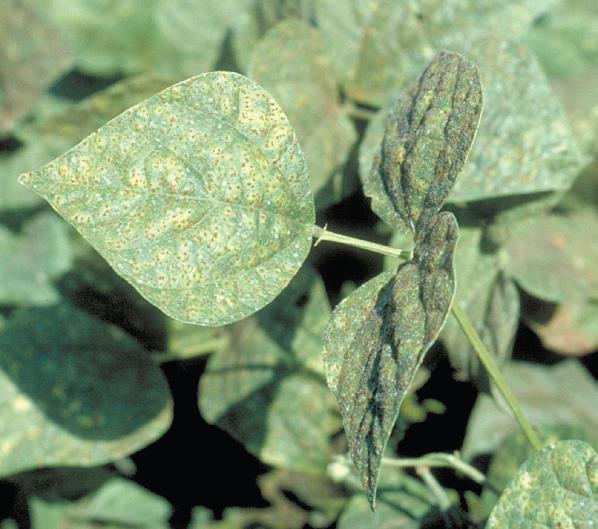Treating Mosaic In Beans: Causes And Types Of Beans Mosaic

Summertime means bean season, and beans are one of the most popular home garden crops due to the ease of care and rapid crop yields. Unfortunately, a garden pest enjoys this time of year as well and can seriously jeopardize the bean harvest-- this is the aphid, only there never really is just one, is there? Aphids are responsible for spreading bean mosaic virus in two ways: bean common mosaic as well as bean yellow mosaic. Either of these types of bean mosaic may afflict your bean crop. The mosaic symptoms of beans afflicted with either bean common mosaic virus (BCMV) or bean yellow mosaic (BYMV) are similar so careful inspection can help determine which one is affecting your plants.
Bean Common Mosaic Virus
BCMV symptoms manifest themselves as an irregular mosaic pattern of light yellow and green or a band of dark green along the veins on an otherwise green leaf. Foliage may also pucker and warp in size, often causing the leaf to roll up. Symptoms vary depending upon the bean variety and disease strain, with the end result either stunting the plant or its eventual death. Seed set is affected with BCMV infection. BCMV is seed borne, but not usually found in wild legumes, and transmitted by several (at least 12) aphid species. BCMV was first recognized in Russia in 1894 and known in the United States since 1917, at which time the disease was a severe problem, lowering yields by as much as 80 percent. Today, BCMV is less of a problem in commercial farming due to disease resistant varieties of beans. Some dry bean varieties are resistant while almost all snap beans are resistant to BCMV. It is important to purchase seeds with this resistance since once the plants are infected, there is no treatment and the plants must be destroyed.
Bean Yellow Mosaic
The symptoms of bean yellow mosaic (BYMV) vary again, depending upon the virus strain, stage of growth at the time of infection, and variety of bean. As in BCMV, BYMV will have contrasting yellow or green mosaic markings on the foliage of the infected plant. Sometimes the plant will have yellow spots on the foliage and, often, the first may be droopy leaflets. Curling foliage, stiff glossy leaves, and generally stunted plant size follow. Pods are not affected; however, the numbers of seeds per pod are and may be significantly less. The end result is the same as BCMV. BYMV is not seed borne in beans and overwinters in hosts such as clover, wild legumes, and some flowers like the gladiolus. It is then carried from plant to plant by more than 20 aphid species, amongst them the black bean aphid.
Treating Mosaic in Beans
Once the plant has either strain of bean mosaic virus, there is no treatment and the plant should be destroyed. Combative measures may be taken for future bean crops at that time. First of all, buy only disease-free seed form a reputable supplier; check the packaging to make sure. Heirlooms are less likely to be resistant. Rotate the bean crop each year, especially if you have had any infection in the past. Do not plant beans near alfalfa, clover, rye, other legumes, or flowers such as gladiolus, which may all act as hosts aiding in the overwintering of the virus. Aphid control is vital to control of bean mosaic virus. Check the underside of the leaves for aphids and, if found, treat immediately with an insecticidal soap or neem oil. Again, there is no treating mosaic infections in beans. If you see light green or yellow mosaic patterns on foliage, stunted growth, and premature plant die back and suspect mosaic infection, the only option is to dig up and destroy the infected plants, then follow through with preventive measures for a healthy crop of bean the following season.
Gardening tips, videos, info and more delivered right to your inbox!
Sign up for the Gardening Know How newsletter today and receive a free copy of our e-book "How to Grow Delicious Tomatoes".

Amy Grant has been gardening for 30 years and writing for 15. A professional chef and caterer, Amy's area of expertise is culinary gardening.
-
 Get Ready For A Summer Of Hummers! Grow These Full Sun Hummingbird Plants and Flowers
Get Ready For A Summer Of Hummers! Grow These Full Sun Hummingbird Plants and FlowersIf you’re lucky enough to enjoy a sunny backyard, make sure you are maxing out on your pollinator opportunities and grow these full sun hummingbird plants and flowers
By Tonya Barnett
-
 12 Lush Alternatives To A Lawn For Sustainable Spaces
12 Lush Alternatives To A Lawn For Sustainable SpacesAlternatives to a lawn are beautiful and also beneficial to your local ecosystem and its pollinators. Explore our top picks for plants to replace grass.
By Tonya Barnett